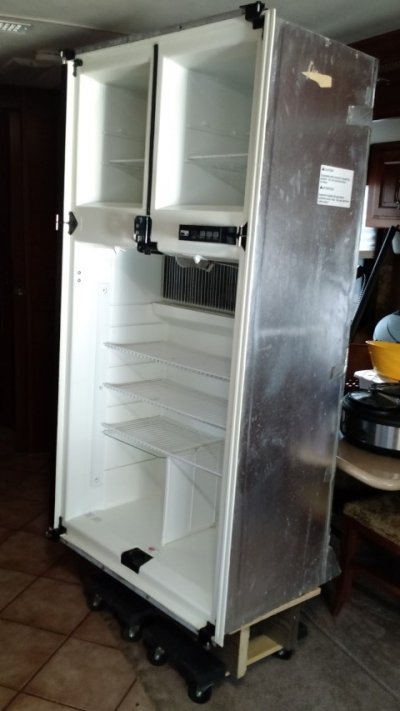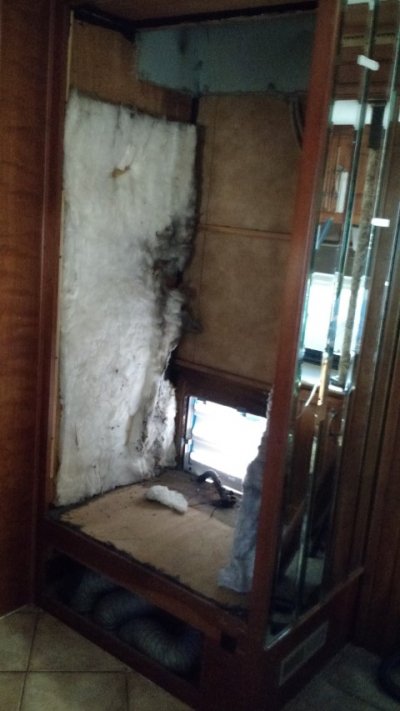Gary RV_Wizard
Site Team
I've begun the process of exchanging our Norcold 1200 fridge for a residential model. The Norcold has performed excellently for the past 12 years, but last summer we noticed it did not get quite as cool as previously. We also have a quirky relay on the circuit board. Then, over the winter, our ARP boiler monitor twice detected an overheat condition and did a temporary shut down. That was enough warning for me - don't want to risk a fridge fire or the hassle of a failure over the coming summer. I've said for the last 3 years that I would replace with a residential when the time came, and the time is NOW.
The fridge we have selected isn't fancy or huge, just a 14.6 cubic foot GE Energy Star model. It will fit in the hole with a bit of room to spare, but is still more than 20% larger than the 12 cu ft Norcold. Nancy is sure gonna like having a frost-free fridge! And a freezer where she can actually see the contents, instead of the dumb Norcold design with two separate freezers, each with a recessed bottom that hides things.
Since my main inverter is a MSW type, I bought a 1200 watt pure sine inverter to power the fridge while driving or otherwise off-grid. I'll wire that to my existing battery bank, which is 4 Group 31 12v Trojan AGMs. The inverter has its own auto-transfer switch, so will manage shore power and inverting. I have that partially installed, but need to do some 120v wiring for the new fridge before I can finish it up. I know several people running their residential fridges on MSW, but I wanted to make sure I had clean power and the fridge compressor running at optimum efficiency.
Wednesday I pulled the Norcold out of the wall, a task that took near half a day, though a chunk of it was simply figuring out what had to be done. I also removed the 4 doors. For those contemplating doing this, the hole for my Norcold was exactly35" 32 3/4" wide and 63" tall, just enough for the case size of the 1200. It fit in their like a glove. The fridge is sitting in the coach lounge area, on a wheeled dolly I made for that purpose. Thursday I had only an hour or so to work on it, so just capped off the LP gas line and ice maker water line. We don't use ice much, so decided to get a portable ice maker rather than take up the freezer space.
Today I stripped the old cooling unit off the back and removed all the control wiring, ice maker, etc. That was necessary to allow the fridge to be taken out through my entry door, and also removes around 75 lbs of weight. It's much easier to handle now that the plumbing & weight is gone. I spent the rest of the afternoon making pieces to close up the exterior wall vent. I want it to be water tight and reasonably insulated, but still removable from the outside in case I need access. I'm basically making an inner wood panel that screws into place from the outside, and also sealing the holes in the plastic exterior panel that color matches the body paint. I plan to put a piece of foam insulation board between those two.
Tomorrows plan is to work on the 120v wiring between inverter and fridge.
Edit: corrected opening size
The fridge we have selected isn't fancy or huge, just a 14.6 cubic foot GE Energy Star model. It will fit in the hole with a bit of room to spare, but is still more than 20% larger than the 12 cu ft Norcold. Nancy is sure gonna like having a frost-free fridge! And a freezer where she can actually see the contents, instead of the dumb Norcold design with two separate freezers, each with a recessed bottom that hides things.
Since my main inverter is a MSW type, I bought a 1200 watt pure sine inverter to power the fridge while driving or otherwise off-grid. I'll wire that to my existing battery bank, which is 4 Group 31 12v Trojan AGMs. The inverter has its own auto-transfer switch, so will manage shore power and inverting. I have that partially installed, but need to do some 120v wiring for the new fridge before I can finish it up. I know several people running their residential fridges on MSW, but I wanted to make sure I had clean power and the fridge compressor running at optimum efficiency.
Wednesday I pulled the Norcold out of the wall, a task that took near half a day, though a chunk of it was simply figuring out what had to be done. I also removed the 4 doors. For those contemplating doing this, the hole for my Norcold was exactly
Today I stripped the old cooling unit off the back and removed all the control wiring, ice maker, etc. That was necessary to allow the fridge to be taken out through my entry door, and also removes around 75 lbs of weight. It's much easier to handle now that the plumbing & weight is gone. I spent the rest of the afternoon making pieces to close up the exterior wall vent. I want it to be water tight and reasonably insulated, but still removable from the outside in case I need access. I'm basically making an inner wood panel that screws into place from the outside, and also sealing the holes in the plastic exterior panel that color matches the body paint. I plan to put a piece of foam insulation board between those two.
Tomorrows plan is to work on the 120v wiring between inverter and fridge.
Edit: corrected opening size


